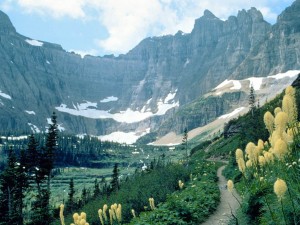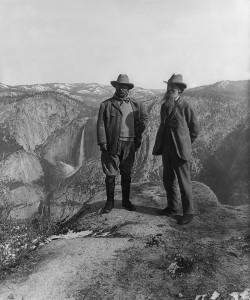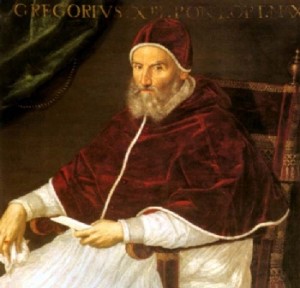Many people enjoy nature, so it is not surprising that they would want to set some land aside as parks or recreational areas to preserve the rugged beauty of nature. It was in this spirit that America’s first National Park, Yellowstone, was established in 1872.
Although people acknowledged the importance of preservation and conservation, for many years there was no systematic approach to the acquisition of land for nature preservation. Indeed, the well-known nature preservationist John Muir took U.S. President Theodore Roosevelt on a tour of the Western United States to impress upon him the need to develop a federal approach to setting up a national park system. But it wasn’t until 1916 that the National Park Service was created under President Woodrow Wilson. The original vision of the National Park Service was “…to conserve the scenery and the natural and historic objects and wildlife therein, and to provide for the enjoyment of the same in such manner and by such means as will leave them unimpaired for the enjoyment of future generations.”
Now, there are over 365 National Park Service areas in the US, including 58 actual National Parks. The National Park Service has been expanded to include:
National Parks: There are 58 of these, including the famous Yellowstone, Yosemite, and Grand Canyon.
National Monuments: There are 74 of these. National Monuments are similar to National Parks – the main difference has to do with how an area is established as a National Monument. Examples of National Monuments include: the Statue of Liberty, Fort McHenry (associated with the war of 1812, and Francis Scott Key inspired to write the Star Spangled Banner), Fort Sumter (the place where the first shot of the American Civil War was fired), and Muir Woods (where the Redwood Forest is, near San Francisco).
National Historical Parks, National Historic Sites, and International Historic Sites: There are 123 areas that fall into this category. These sites are sites of historic significance, or are a significant cultural resource, or have some significant cultural or natural feature. Examples include Ford’s Theatre (where President Abraham Lincoln was assassinated) and Colonial National Historical Park, which contains the Jamestown National Historic Site (where the first permanent English settlement in North America was located).
National Memorials: There are 28 National Memorials, which memorialize a historic person or event. Examples include the Jefferson Memorial, the Lincoln Memorial, Mount Rushmore, and the Washington Monument.
National Military Parks / National Battlefield Parks / National Battlefield Sites / National Battlefields: There are 24 sites that fall under this category. They are battle sites preserved by US government, including Gettysburg National Military Park and Gettysburg National Cemetery, and Shiloh National Military Park.
National Parkways: There are 4 protected scenic roadways, including the Blue Ridge Parkway located in the Appalachian Mountains.
National Recreation Areas: There are 18 sites designated as National Recreation Areas, where the primary focus is on water-based recreation. An example of this is Golden Gate National Recreation Area near San Francisco.
National Lakeshores / National Seashores: These are coastal areas that have been preserved for their beauty. There are 4 National Lakeshores, all in the Midwest: Sleeping Bear Dunes in Michigan, the Apostle Islands in Wisconsin, the Indiana Dunes, and Pictured Rocks in Michigan. There are 10 National Seashores, including Padre Island in Texas, Cape Cod in Massachusetts, and Cape Hatteras in North Carolina.
National Rivers and National Wild and Scenic Rivers and Riverways: There are 15 rivers or riverways that have this designation for their scenic, recreational, geologic, fish & wildlife, historic, and cultural importance. An example of this is the East Branch of the Tahquamenon River in Michigan’s Upper Peninsula.
National Scenic Trails: There are 11 trails of particular natural beauty that have received this designation, including the Appalachian National Scenic Trail and the Continental Divide National Scenic Trail.
There is an entrance fee for the National Parks. This fee ranges from $7 – $20, but it is good for seven days. If you are planning on visiting a lot of National Parks, you can instead buy an annual pass (known as the “America the Beautiful pass” for $80. This annual pass is good for an entire year from the date of purchase.
What can you do at a National Park? All kinds of things, depending on the particular park, and the time of year. Possible activities include:
- Camping (RV, tent, backpacking)
- Hiking
- Biking
- Climbing
- Swimming / Scuba diving
- Skiing
- Snowmobiling
- Boating / Canoeing / Kayaking
- Horseback riding
- Picnicking
- Fishing
- Hunting
- Birdwatching / Wildlife viewing
The most popular National Parks:
- Yosemite National Park, California. Established 1890. In 2011 it had 3,951,393 visitors.
- Glacier National Park, Montana. Established 1910. In 2011 it had 1,853,564 visitors.
- Acadia National Park, Maine. Established 1916. This was the first national park east of the Mississippi River. In 2011 it had 2,374,645 visitors.
- Zion National Park, Utah. Established 1909. In 2011 it had 2,825,505 visitors.
- Grand Teton National Park, Wyoming. Established 1929. In 2011 it had 2,587,437 visitors.
- Denali National Park, Alaska. Established 1917. This was originally named Mount McKinley National Park, and it is home to the highest mountain in North America. In 2011 it had 406,582 visitors.
- Arches National Park, Utah. Established 1929. In 2011 it had 1,040,758 visitors.
- Grand Canyon National Park, Arizona. Established 1919. In 2011 it had 4,298,178 visitors.
- Yellowstone National Park, Wyoming. Established 1872. This is the oldest National Park. In 2011 it had 3,394,322 visitors.
- Rocky Mountain National Park, Colorado. Established 1915. In 2011 it had 3,176,941 visitors.




